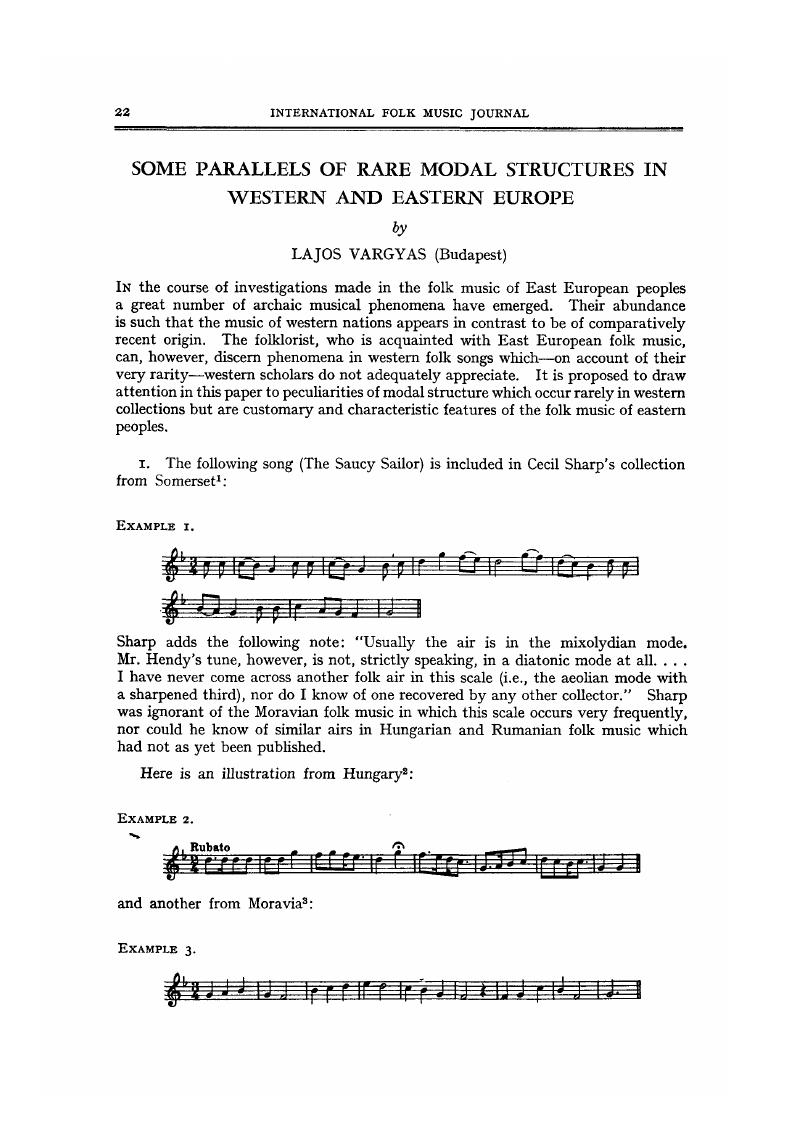Published online by Cambridge University Press: 07 March 2019

Unless otherwise stated Bartók refers to Béla Bartók: Hungarian Folk Music. London, 1931.
1. Cecil J., Sharp—Charles L., Marson: Folk-Songs from Somerset, London, 1905-9, No. 92.Google Scholar
2. Példatár: Collection of tunes compiled by L., Vargyas to Z., Kodály's A magyar népzene (Hungarian Folk-music), 3rd ed. Budapest, 1952, No. 332.Google Scholar (See also Nos. 9, 331, 370, 343, 344, 370 and 473.) (No. 9 = Bartók, No. 40; No. 331 = Bartók, No. 280.)
3. František, Sušil: Moravské národni pisně. 3rd ed. Praha, 1941.Google Scholar (1st ed. 1832.) No. 139. Other examples are Nos. 4, 9, 17, 36-38, 119, 160, 186, 228, 296, etc.
4. Béla, Bartók: Cȃntece popolare romȃnești din comitatul Bihor (Ungaria). București, 1913. No. 132.Google Scholar (See also No. 168 and others.)
5. Joseph, Canteloube: Anthologie des chants populaires français. I-IV. Paris, 1951. II, p. 271.Google Scholar (See also III, p. 176.)
6. Cecil J., Sharp: English Folk Songs from the Southern Appalachians. Ed. by Maud, Karpeles. I-II. London-New York-Toronto, 1952. No. 140 K.Google Scholar
7. Marij kalyk muro. Leningrad-Moscow, 1951. Nos. 56, 58, 78, 87, 89, 94, 145, 148, 151, 153-7, 166,168, 203, 208-9, 212, (217), 231-2, 237, 244, 267. Also in Robert, Lach: Gesänge russischer Kriegsgefangener. I. Bd. 3.Google Scholar Abt. Tscheremissische Gesänge. Wien, 1929. (Ak. d. Wiss. Phil.-Hist. Kl., Sitz. b. 204. Bd., 5. Abh.) Nos. I-II, etc.; MF 624C in Ethn. Mus. Budapest; Collected by J. Wichmann.
8. Op. cit. Note 2. Nos. 186-187. (No.187=Bartók, No. 146.)
9. Op. cit. Note 6. Nos. 5B, 49M, 82F, 82G, 106D.
10. Cecil J., Sharp: English Folk Songs: Some Conclusions. 3rd ed. revised by M., Karpeles. Methuen, London, 1954 (Ist ed. 1901), p. 71.Google Scholar
11. Béla, Bartók: Hungarian Folk Music. London, 1931, p. 18.Google Scholar
12. Zoltán, Kodály: Die ungarische Volksmusik. Budapest, 1956, p. 25.Google Scholar
13. MF 624a, b, 625a, 627a, b, 628a; also, neutral third and sixth together in MF 625b.
14. Op. cit., Note II, p . 18; also op. cit. Note 2.
15. Béla, Bartók—Albert B., Lord: Serbo-Croatian Folk Songs. Texts and transcriptions of seventy-five folk songs from the Milman Parry collection and a morphology of Serbo-Croatian folk melodies. New York, 1951. No. 34b, 45,Google Scholar also 23b and 50.
16. V. K., Stechenko-Kouftina: Drevnejshie instrumentalnye osnovy grusinskoj narodnoj musyki. I. Flejta Pana.—Les plus anciens fondements instrumentaux de la musique populaire gébrgienne. I. Le flûte de Pan. Tiflis, 1936 Google Scholar: See Chapter V, and the cent-table on p. 172 in particular (p. 228 in the French summary). The book in question was reviewed in detail in the Sovietskaia Ethnographia 1938, pp. 193-198 q.v.
17. Op cit., Note 6. No. 110E and op cit., Note 1. No. 34.
18. Op. cit., Note 4. No. 173.
19. Op. cit., Note 5. I, 187, 328. (= Bartók, No. 226). II, 17, 211, 316, 408. III, 172. IV, 416.
20. Op. cit., Note 2. Nos. 180, 189, 440 (= Bartók, No. 131) and 441 ( = Bartók, No. 128), etc.
21. Op. cit., Note 11, pp. 40-41.
22. V. M., Vasilev: Marij Muro. Kazan, 1919. No. 22.Google Scholar
23. See Szendrey, Zsigmond—Kodály, Zoltán: Nagyszalontai gyujés. Budapest, 1924. Tunes 5 and 6 and notes, p. 365.Google Scholar
24. Corpus Musicae Popularis Hungaricae. II, No. 865.
25. Jérome, Bujeaud: Chants et chansons populaires des provinces de I'Ouest, Saintonge, Aunis et Angoumois, I-II. Niort, 2 ed. 1895. II, 156.Google Scholar
26. Op. cit., Note 1. No. 126.
27. For a typical air of this kind see op. cit., Note 24. II, 855. See also Nos. 776-876.
28. See Charles, Beauquier: Chansons populaires recueillies en Franche-Comé. Paris, 1894. No. 90.Google Scholar In the major key, op. cit., Note 5. III, 345. Also in Dorian key, Achille, Millien: Chants et chansons. Litérature orale et traditions du Nivernais, I-III. Paris, 1906-8-10. I, p. 209.Google Scholar
29. L., Vargyas: Francia párhuzam regösinékeinkhez: Les chants de quêtes pour le nouvel an dits “regös” et quelques parallèles français. In: Néprajzi Közleminyeh, II (1957), No. 1–2, pp. 1-10.Google Scholar